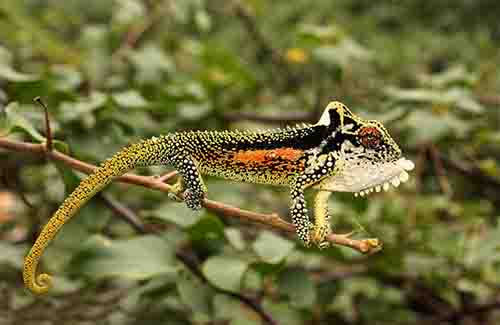
Description:
Scientific name: Bradypodion thamnobates
Life span: 5-7 years
Its body is covered in bulbous scales of various hues. White skin covers its throat, and the head crest is yellow. Females are brown with smaller helmet-like protrusions, while males have a short orange stripe around the middle of their bodies and red eyelids. The rest of the time, their coloration varies greatly.
Native Region/Habitat
Due to their apparent overlap in eastern Lesotho and neighboring South Africa, the ranges of the Drakensberg dwarf chameleon (B. dracomontanum), the Midlands and Gilboa Forest populations, and both populations need to be defined. Nonetheless, there appears to be little to no significant gene exchange between the Drakensberg species and the KwaZulu-Natal group.
Behavior:
These advanced care, high maintenance reptiles are not suitable as a first reptile or as a pet for a youngster since they are easily stressed out by handling and are harsh if the husbandry, supplements, and nutrition are not done properly.
Care As a pet/In captivity:

Housing:
To ensure sufficient airflow, it is advisable to maintain most chameleon species in mesh screen cages. Enclosures for people must measure no less than 18 x 18 x 36 inches (45 x 45 x 90 cm). Young animals can be housed in more compact spaces that can be expanded, as they get older. Although it is advisable to never cohabit with chameleons, females have been observed to get along with this particular species. If you are unfamiliar with chameleons, avoid trying to keep them together as it is not advised. Adults are really eager to assault one another and do not get along at all.
Temperature & Humidity:
Many people are surprised by how successfully these chameleons adapt to climate change in the wild. Where these chameleons are from, winters do in fact bring snow. This doesn’t imply that you should let them become cold on purpose throughout the winter. With an ambient temperature of roughly 77-80°F (25-26°C) and a cold side of about 75°F (24°C), a basking spot of 85°F (30°C) can be offered year-round. Its okay for the temperature to drop at night, but don’t let them dip below 50°F / 10°C.
While shedding, the humidity should be maintained at about 65% but can range from 55 to 65%.
Feeding:
As chameleons are predominantly insectivores, it is best to feed them a variety of insects to keep them engaged (chameleons might get bored with the same item after a while) and to give them a well-balanced diet. Since live bugs have the highest nutritional content, they must always be fed. Fruits and vegetables are neither necessary nor advised for them and offer no benefits at all.
5-7 small crickets (slightly larger than 1/4 and increasing to 1/4 as they grow larger) are consumed daily by juvenile chameleons, while 5-7 medium crickets (or small roaches) are consumed daily by adults.
Table





